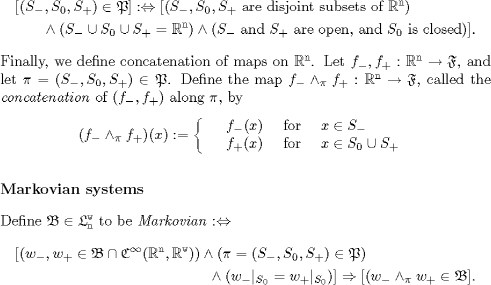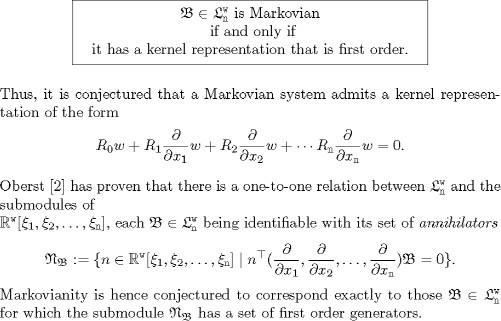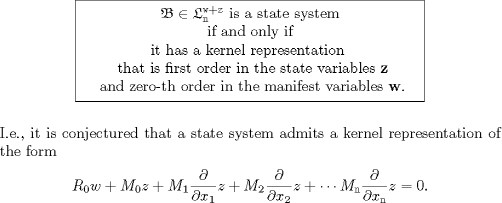Problem 1.12
State and first order representations
Jan C. Willems1
Department of Electrical Engineering - SCD (SISTA)
University of Leuven
Kasteelpark Arenberg 10
B-3001 Leuven-Heverlee
Belgium
1 DESCRIPTION OF THE PROBLEM
We conjecture that the solution set of a system of linear constant coefficient PDEs is Markovian if and only if it is the solution set of a system of first order PDEs. An analogous conjecture regarding state systems is also made.
Notation
First, we introduce our notation for the solution sets of linear PDEs in the n real independent variables x = (x1, . . . ,
xn). Let ![]() denote, as usual, the set n of real distributions on
denote, as usual, the set n of real distributions on![]() and
and ![]() wnthe linear subspaces of
wnthe linear subspaces of ![]() consisting nof the solutions of a system of linear constant coefficient PDEs in the w real-valued dependent variables w =
col(w1, . . . , ww). More precisely, each element
consisting nof the solutions of a system of linear constant coefficient PDEs in the w real-valued dependent variables w =
col(w1, . . . , ww). More precisely, each element ![]() is defined by a polynomial matrix
is defined by a polynomial matrix ![]() with w columns, but any number of rows, such that
with w columns, but any number of rows, such that

We refer to elements of ![]() as linear differential n-D systems. The above PDE is called a kernel representation of
as linear differential n-D systems. The above PDE is called a kernel representation of ![]() . Note that each
. Note that each ![]() has many kernel representations. For an in-depth study of
has many kernel representations. For an in-depth study of ![]() , see [1] and [2].
, see [1] and [2].
Next, we introduce a class of special three-way partitions of ![]() Denote by
Denote by ![]() the following set of partitions of
the following set of partitions of ![]() :
:

Think of S- as the “past”, S0 as the “present”, and S+ as the “future.”
Markovian means that if two solutions of the PDE agree on the present, then their pasts and futures are compatible, in the sense that the past (and present) of one, concatenated with the (present and) future of the other, is also a solution. In the language of probability: the past and the future are independent given the present.
We come to our first conjecture:

State systems


Think again of S- as the “past”, S0 as the “present”, S-+ as the “future” . State means that if the state components of two solutions agree on the present, then their pasts and futures are compatible, in the sense that the past of one solution (involving both the manifest and the state variables), concatenated with the present and future of the other solution, is also a solution. In the language of probability: the present state “splits” the past and the present plus future of the manifest and the state trajectory combined.
We come to our second conjecture:

2 MOTIVATION AND HISTORY OF THE PROBLEM
These open problems aim at understanding state and state construction for n-D systems. Maxwell’s equations constitute an example of a Markovian system. The diffusion equation and the wave equation are non-examples.
3 AVAILABLE RESULTS
It is straightforward to prove the “if”-part of both conjectures. The conjectures are true for n = 1, i.e., in the ODE case, see [3].
BIBLIOGRAPHY
[1] H. K. Pillai and S. Shankar, “A behavioral approach to control of distributed systems, ” SIAM Journal on Control and Optimization, vol. 37, pp. 388-408, 1999.
[2] U. Oberst, “Multidimensional constant linear systems, ” Acta Applican-dae Mathematicae, vol. 20, pp. 1-175, 1990.
[3] P. Rapisarda and J. C. Willems, “State maps for linear systems, ” SIAM Journal on Control and Optimization, vol. 35, pp. 1053-1091, 1997.
1This research is supported by the Belgian Federal Government under the DWTC program Interuniversity Attraction Poles, Phase V, 2002 - 2006, Dynamical Systems and Control: Computation, Identification and Modelling.
